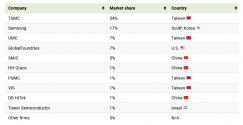I think the production costs for US is a point to be made for pretty much everything except chips. While it may cost a bit more, there absolutely is demand. And if the US manages to take that away from TSMC and Samsung, they are the only shop in town at the 5nm, 7nm level. Now the Americans may not go as far as destroying "allied" foundries through those economic and political means but they do seem interested in consolidating chipmaking abilities inside the US.
China getting there may or may not attract many partners who will contract Chinese foundries to make their chips, simply because there are close to no others out there with their own chip lines e.g. like Huawei (but not Chinese) who don't already have close connections to the established Asian players and will have connections to American foundries.
Some Indian tech companies are beginning to design their own chips and they currently will be using Korean or Taiwanese foundries but they won't be using any Chinese ones due to various political reasons and will consider an American one. Even without foreign customers, those American ones will have American business.
Except that is not what has been happening historically. The memory industry was the first to go since the barriers to entry were lower. The US first lost dominance to Japan and Japan lost it to South Korea. Chip fabrication for logic remained in the US, until TSMC and Samsung came up with the fab model and fabrication in the US mostly evaporated with the notable exceptions of Intel and Micron which have vertically integrated models. The dominant CPU architecture, ARM, isn't US exclusive either.
Now, a company like Apple in theory could gather enough capital to make their own semi fabs. But they failed to do in the past and they have ZERO expertise in process development. The process expertise for logic in the US is in Intel (it keeps sliding backwards though), and the IBM/GlobalFoundries/Samsung alliance. With regards to those guys IBM now mostly outsources its process development and all its fabrication to Samsung. IBM sold its fabs to GlobalFoundries and the GlobalFoundries owners in Abu Dhabi after several years decided to throw in the towel and stopped investing in new process development. So their branch of development is basically finished except for perhaps a couple of guys working on a lab making a process to gain IBM some more patents while Samsung ends up using something else.
While US companies remain committed to stock buybacks instead of capital investment US manufacturing isn't going to go anywhere. Be it Boeing who ended up outsourcing the design and fabrication of most of its new aircraft like the 787, or be it Apple, who would rather Foxconn or someone else do the heavy handed capital investments while they collect the profits.
When you hear US companies say they want US government investment to build new fabs, and the government will give all of them $20 billion, or whatever, then you know it will be a failure. That won't cover the cost of a single new fab, and you need to retool or build a new one every two years or so.

